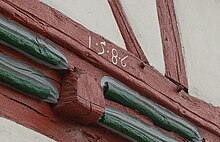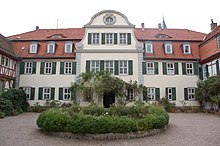Jestädt
|
Jestädt
Community Meinhard
Coordinates: 51 ° 12 ′ 50 ″ N , 10 ° 1 ′ 5 ″ E
|
|
|---|---|
| Height : | 163 m above sea level NHN |
| Area : | 6.17 km² |
| Residents : | 788 (Sep. 2014) |
| Population density : | 128 inhabitants / km² |
| Incorporation : | December 31, 1971 |
| Postal code : | 37276 |
| Area code : | 05651 |
Jestädt is a district of the Meinhard municipality in the Werra-Meißner district in northern Hesse .
Geographical location
Jestädt is located on the extreme southwest foothills of the Gobert ridge in the Werra valley . The Mühlbach flowing through it flows into this river to the south of the village and the weirs to the west-southwest near the village . Neighboring towns are Motzenrode in the north-northeast, Neuerode in the east-northeast, Grebendorf in the east-south-east, Niederhone in the south and Albungen in the north-west. State road 3403 and district road 3 meet in Jestädt .
history
Jestädt was first mentioned in a document in 876. The fortified village "Gestede" was built to secure a ford through the Werra. According to Prof. Haas, Fulda, the place name consists of two words, namely the adjective Old High German gahi , Middle High German gaehe or gah , which in addition to “suddenly” also means “suddenly”, steeply sloping, and the word instead of = Site. According to this, Gahesteti or Jestaedt is a place on the steep slope, as applies to the location of Jestädt. Wine was already being grown in Jestädt in the 10th century .
In the 11th century the Werra valley formed the border between the Kurmainzer bishops and the Guelph dukes and was therefore contested. Jestädt itself belonged to the Count of Everstein . It later became the property of Count von Northeim, Otto von Northeim , who had died before the Eversteiners appeared. His son Siegfried III. von Boyneburg finally acquired the possession of Jestädts.
In 1410, Bernhard I enfeoffed the Boyneburg- Hohensteins with the village of Jestädt and the jurisdiction there. In addition to Jestädt, the Jestädt court included the towns of Motzenrode and Neuerode and the deserted areas of Bettelsdorf, Dörrenhain and Dudenhusen. Contrary to frequent older claims, Jestädt never became part of the landgrave's office in Bischhausen , which was founded in 1654 , but remained part of the semi-autonomous Boyneburg court . The Lords of Boyneburg-Hohenstein kept the Jestädt court as a Brunswick fief until it died out in 1792, while they carried the neck court from the Landgraviate of Hessen-Kassel as a fief. In 1794 the Principality of Braunschweig enfeoffed the Lords of Eschwege with the village. Since 1821 the place belonged to the Eschwege district .
On December 31, 1971, the previously independent municipality of Jestädt was incorporated into the new municipality of Meinhard as part of the regional reform in Hesse .
politics
The mayor of Jestädt is Gerhard Pippert (SPD). Status 2014.
Attractions
- Round anger
- medieval village church
- Jewish cemetery from the 17th century
Jestädt Castle
The Castle Jestädt let Walrab of Boyneburg-Hohenstein 1558 on the walls of to 1561 Talburg built. His son Friedrich Hermann von Boyneburg-Hohenstein (1564–1631) had the castle expanded in 1612. During the Thirty Years' War the castle was looted and devastated; In 1637 it was renovated and from then on served the Boyneburgs as a noble seat .
Only when the Jestädter line of the family died out in 1792, the castle and the associated areas fell to the Lords of Eschwege in 1794 . This property was 1802 by a letter of fief Georg III. approved.
Later the prison tower and the east wing of the castle were removed. The castle was last rebuilt in 1906. The mill adjacent to the south was demolished in the 1960s.
After the Second World War , the Eschweges took refugees and relatives into their castle. In the 1970s and 1980s, the castle was temporarily uninhabited.
In 1990 the castle was sold and renovated until 1998. It has been inhabited again since 1999 and offers four holiday apartments . Concerts are occasionally held in the inner courtyard and in the hall.
Personalities
Friedrich von Feilitzsch (1858–1942), the first Prime Minister of Schaumburg-Lippe , was born in Jestädt.
Individual evidence
- ↑ a b Jestädt, Werra-Meißner district. Historical local dictionary for Hessen. (As of January 25, 2016). In: Landesgeschichtliches Informationssystem Hessen (LAGIS).
- ↑ Population figures of the districts in the 2015 budget of the municipality of Meinhard (preliminary report, page 2) , accessed in February 2016
- ↑ Thomas Diehl: Aristocratic rule in the Werra area. The Boyneburg court in the process of laying the foundations for early modern statehood (late 16th to early 18th century), Hessian Historical Commission Darmstadt and Historical Commission for Hesse, Darmstadt and Marburg 2010, ISBN 978-3-88443-314-0 (sources and Research on Hessian History 159).
- ^ Federal Statistical Office (ed.): Historical municipality directory for the Federal Republic of Germany. Name, border and key number changes in municipalities, counties and administrative districts from May 27, 1970 to December 31, 1982 . W. Kohlhammer GmbH, Stuttgart and Mainz 1983, ISBN 3-17-003263-1 , p. 388 .
- ↑ Information on the village church
- ^ Website of Jestädt Castle
Web links
- Jestädt district on the Meinhard municipality's website
- Jestädt, Werra-Meißner district. Historical local dictionary for Hessen. In: Landesgeschichtliches Informationssystem Hessen (LAGIS).
- Literature about Jestädt in the Hessian Bibliography




